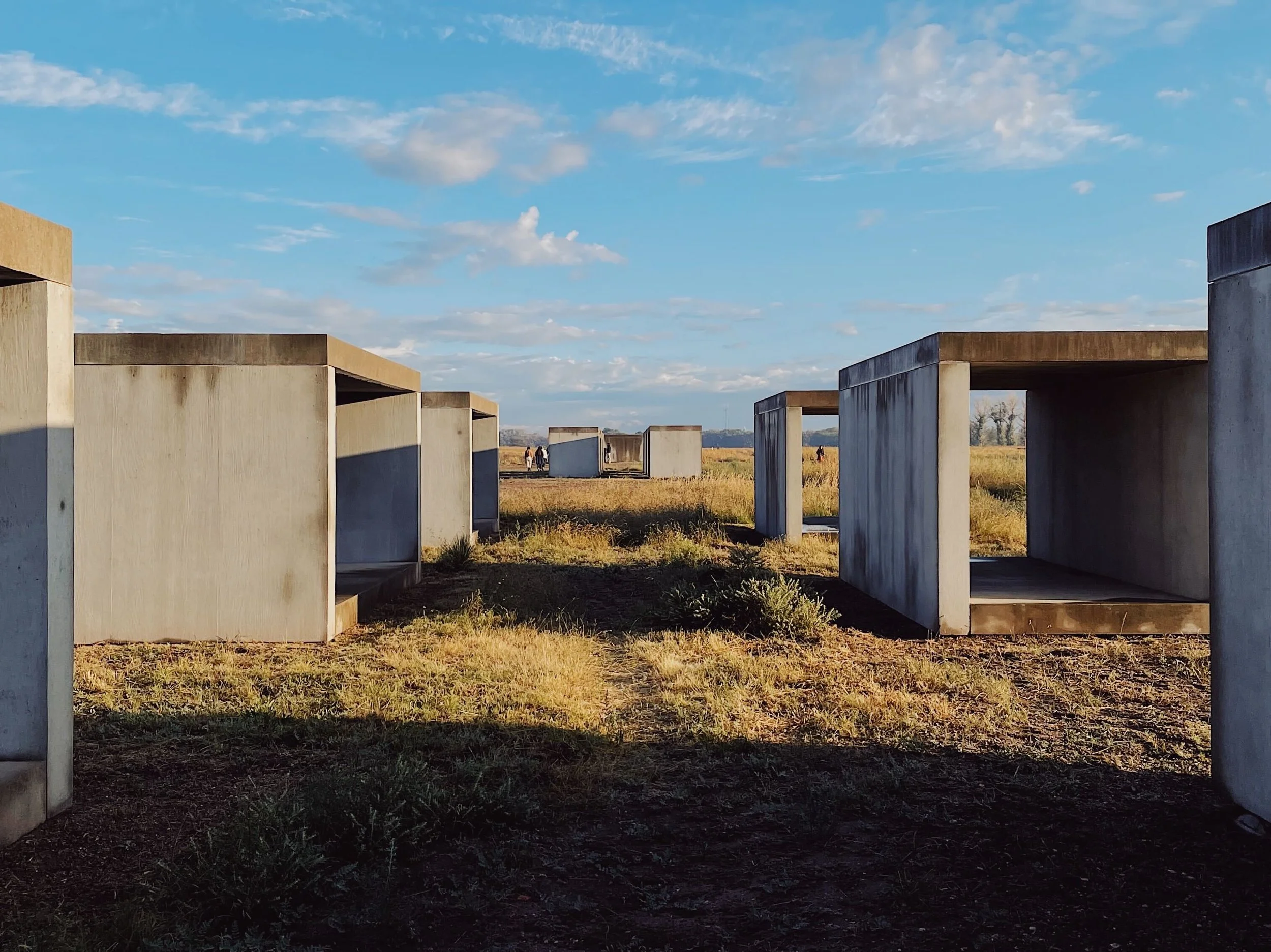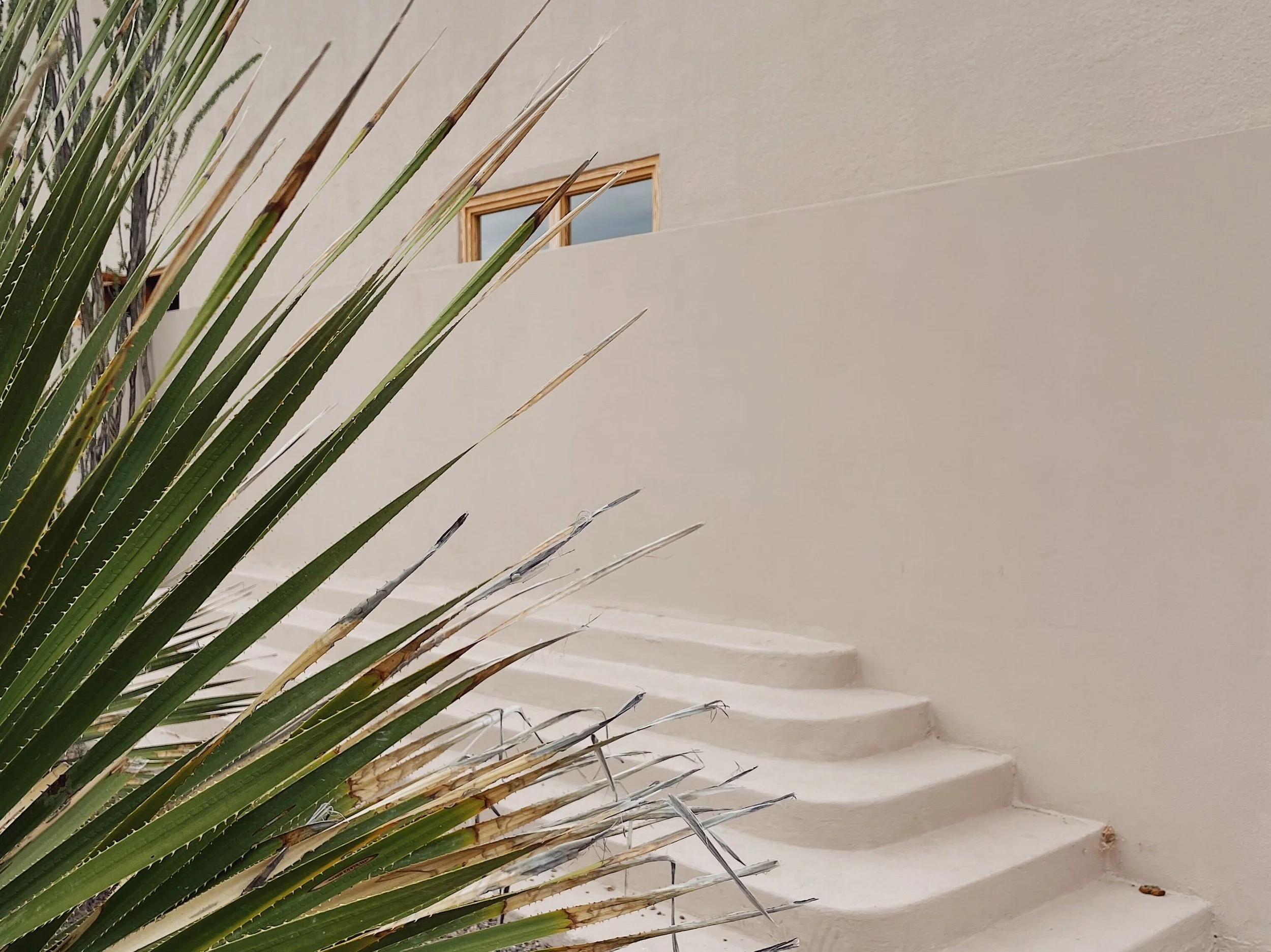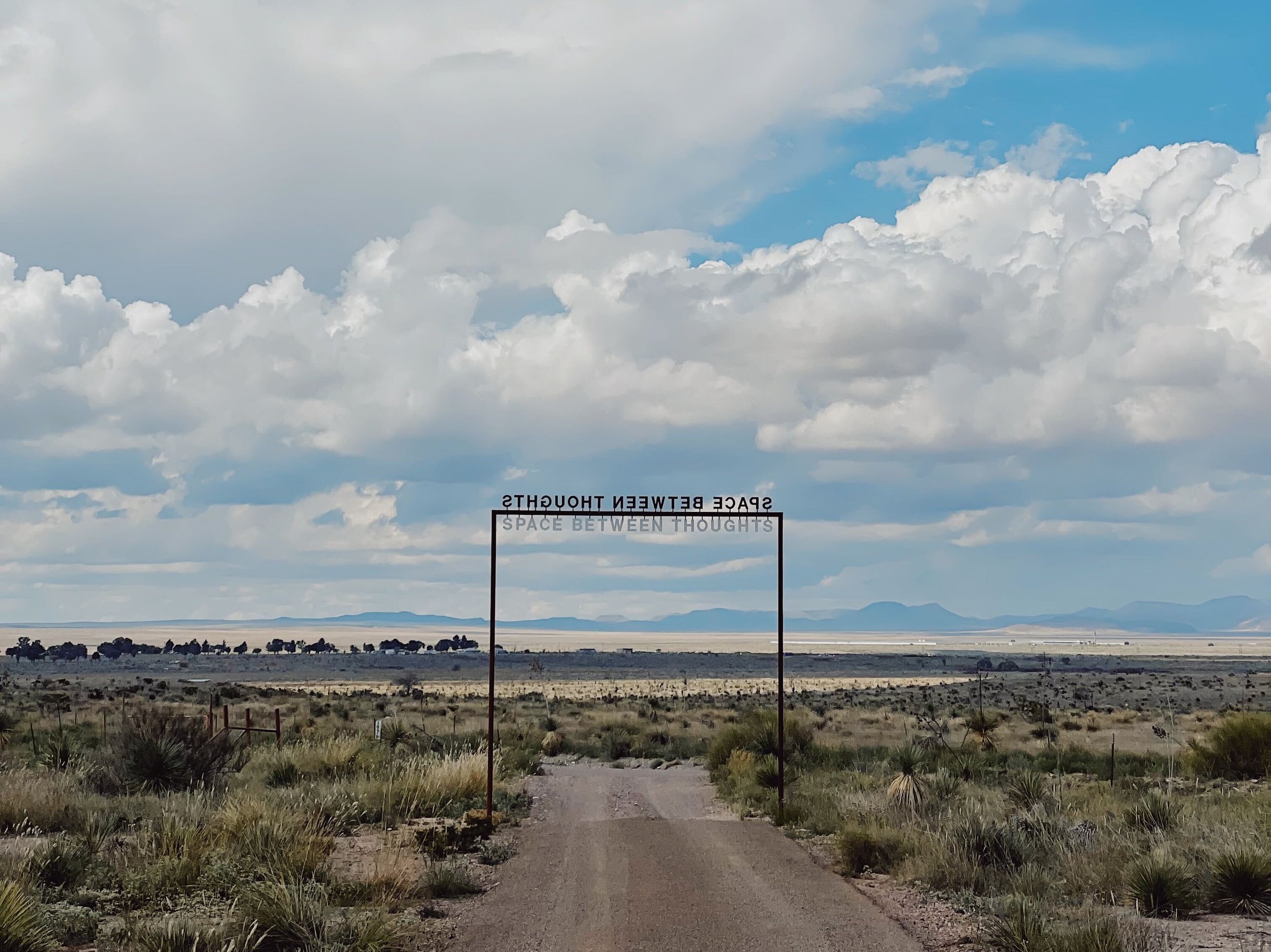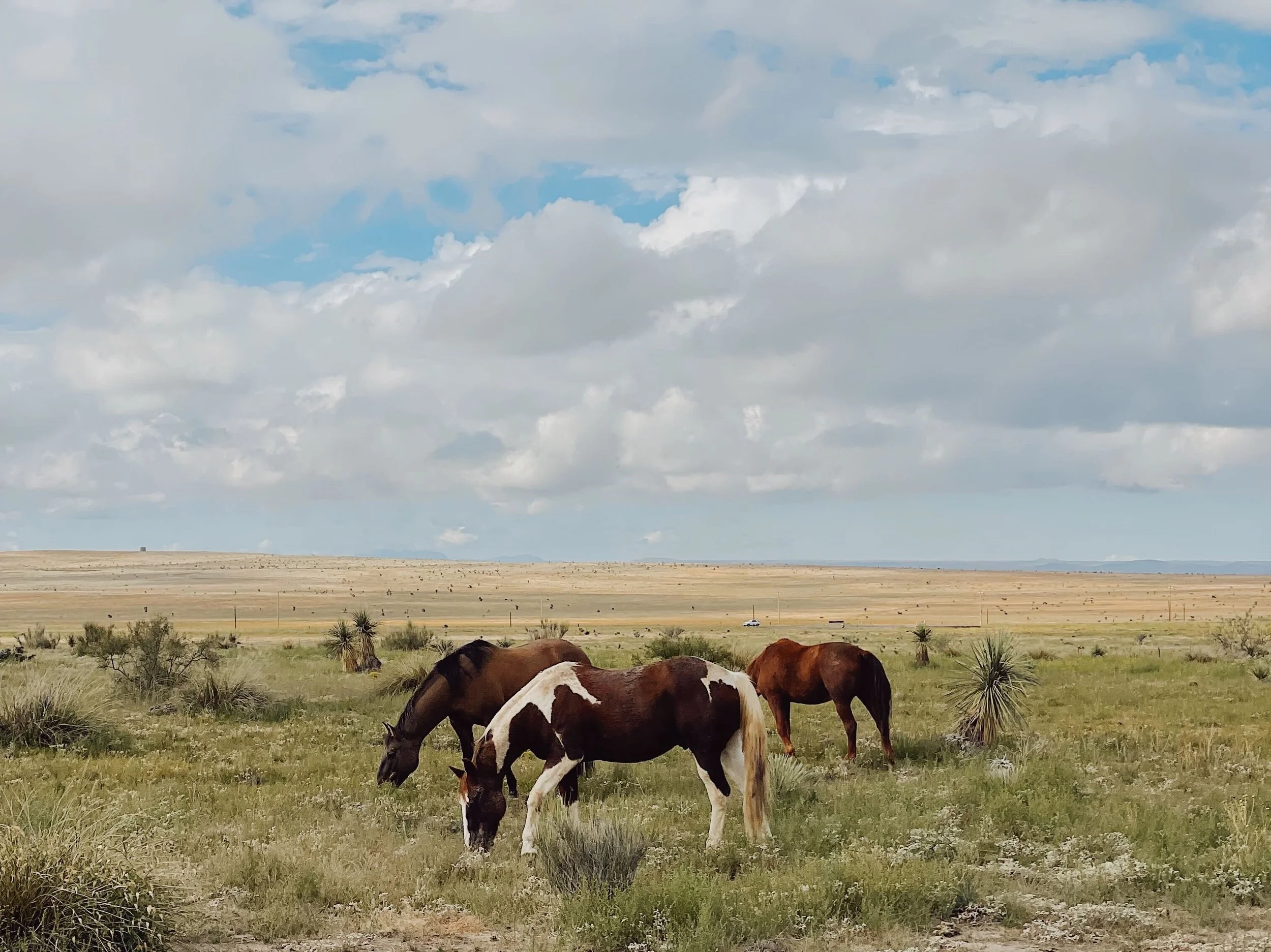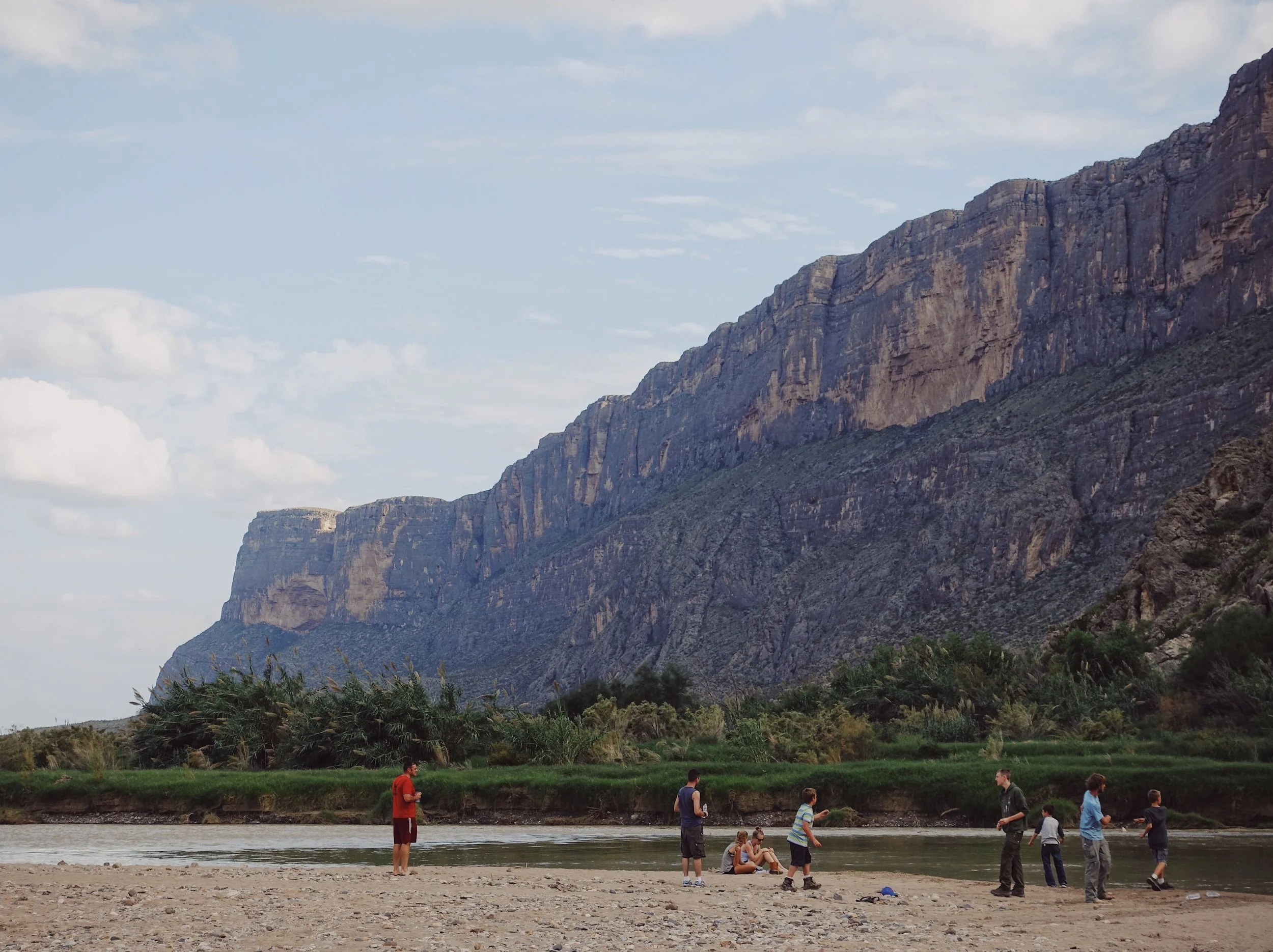Seeking spirituality in the mystical town that modern artist Donald Judd helped build.
Sleepy Marfa, Texas: Try the sotol at the Marfa Spirit Co. (on the left) and get your caffeine fix at the Sentinel coffee shop (to the right).
On Sunday we wake to our alarms set for 7:30 a.m. We crawl out of bed, run to the bathroom, throw on clothes — no time to brush teeth or make coffee. We’re not leaving town just yet. In fact, this is one of the reasons we arrived in the first place. I draw the bedroom curtains open in a panic. Phew. Okay, we’re okay — we have time. The sky is still an indigo gradient spreading across the Davis Mountains in the distance. And of course it is: The sun doesn’t rise until 7:50 something.
We’re headed across town to the Chinati Foundation for an annual sunrise viewing of Donald Judd’s 15 untitled works in concrete.
A ranch horse outside of Big Bend National Park
“It’s all about the light.”
All sense of anxiety — to be on time — flees once we arrive. Folks park their cars along the main road leading to the foundation’s gates. People seem to be getting out of their cars and making their entrance in slow motion. Maybe they’re hungover from the free booze at the arena last night. Maybe they also had to skip the coffee this morning. Or maybe this place is just demanding our slow presence, asking us to be aware.
The 15 works in concrete are actually 15 separate arrangements of concrete rectangular prisms stretching north to south in a straight one-kilometer line. There are 60 boxes in total. Each unit contains the same dimensions, 2.5 by 2.5 by 5 meters, and is built with concrete slabs 25 centimeters thick. Each work plays with shape and light — some with units arranged into triangles and others into rectangular patterns; some with three in a group, others with six. Throughout the works, the individual units showcase variety. Some are completely closed boxes and others allow light and air to permeate: sometimes on the long sides, sometimes on the short ends.
The light changes everything when viewing Donald Judd’s untitled concrete works in Marfa, Texas.
There’s a stillness in the air this morning. Not creepy or eerie. Just still. Calm. As we descend the path leading to the sculptures — every step leaving new, prickly grass burs stuck to our boots — I can tell the sun has broken above the horizon. I can’t see it behind the pony wall of clouds, but I know it. The once-indigo sky is getting brighter and lighter by the moment. Fog in the distance is becoming more obvious and the dew on the desert grass is catching the light.
Judd’s works, finished in 1984, can be found on a former military compound.
Once we get down to the long line of concrete boxes, I know I want us to walk south. There’s a small hill at the end. It’s the only place on campus where you can see all 15 works at once. On a mission, in a race against time — I wasn’t sure how quickly the sun would rise above the clouds — we led the march atop the hill. And then we just stood there. Watching other observers and observing ourselves. Resting. Waiting. I wanted this perspective for when the light rose above the clouds and spilled out onto the land and through the sculptures.
The gorgeous scenery in nearby Big Bend National Park
Donald Judd’s Mission and My Personal Pilgrimage
For a long time I’ve struggled with what it means for something to be spiritual or to be a spiritual person. I’ve identified as nonreligious since my early 20s, shortly after coming out. I think growing up in an evangelical family made me believe that anything spiritual was inherently related to God. And when I left the Southern Baptist church, I had no intention of going back or being associated with religion ever again. I didn’t want to talk about spirituality, much less think about it — it was all tied up in terrible church experiences.
Though, the first time I watched the sun creep above the horizon, stretch its golden light across the surfaces of the Judd pieces and pour a warm glow throughout the Texas desert, it clicked. I thought, “This is spiritual.”
The entrance to the Chinati Foundation’s John Chamberlain Building
Throughout his career, Judd was interested in ideals of autonomy (a key principle of minimalism), both for the artist and for the artist’s works, hence his anti-museum philosophy and developing this middle-of-nowhere campus for creating and showing his work and that of his contemporaries. For the sculptures, though, a driving concept was his interest in space — how an object takes up and contains space and how an object can be permanent and site-specific. Or as Judd put it, he was interested in “specific objects.” I interpret “specific” to mean both mathematical but also unique to the space in which the object resides.
All of Judd’s sculptures demand your awareness of the space around them, either through scale, texture, color, reflective qualities, placement or some mixture of attributes.
I’m so drawn to the concrete works because they practically beg you to fall in love with the light and land around them. The Brutalist forms cast geometric shadows, sharp lines amid desert grasses, prickly Texas dirt and a soft view of the Davis Mountains on the horizon. It’s an emotional juxtaposition asking you to consider yourself against the land, by way of the art itself. It’s a manmade proposition with an unavoidable spiritual consequence.
Inflection Point by Darren Almond (2022) frames the entrance to the Hetzler Marfa gallery property.
If you get the opportunity to visit Marfa, here are tips from someone who has visited five times since 2015.
4 Tips to Get the Most Out of Marfa
1. Get the full Judd experience.
Some people are drawn to Marfa by the quirky allure of a small art town in the middle of nowhere, or by the iconic Prada Marfa installation (26 miles outside of town, LOL), or by the rentable bohemian trailers and yurts of El Cosmico. And many of them have no clue about the Chinati Foundation or who Donald Judd was. It’s sad not just because they’re missing out on a key contribution to modern art history, but also because without Judd’s arrival, Marfa would likely still be in collapse after Fort D.A. Russell was decommissioned in 1949 (the main site of Judd’s campus).
The Judd Foundation
I love visiting Marfa during the annual Chinati Weekend, when the foundation opens its doors to the public for self-guided tours, and the town’s shops and galleries hold special hours for the influx of visitors.
Outside of that early October weekend, I do recommend visiting when Chinati hosts a sunrise or sunset viewing and also making an appointment for a full collection tour (a four-and-a-half-hour experience).
Caleb’s husband, Brennan, reading the exhibition guide at Ballroom Marfa gallery during Chinati Weekend Open House in 2022
The Judd Foundation — the organization charged with preserving Judd’s living and working spaces, libraries and archives in NYC and Marfa — also provides rich tours of the artist’s other sites throughout town.
Slow down and forgo your expectations. You’re on Marfa time.
2. Know that Marfa operates on Marfa time, and the town is always changing.
Planning for trips is not in my nature. I hate it. But your trip to Marfa needs planning. For one, there is a limited number of places to eat, drink and stay (see also: gentrification in Marfa). Second, that list of places is always changing. If you read a list of things to do from this year, I can guarantee it will be outdated in less than 12 months. And finally, a business’ hours of operation are far from predictable. We passed a bookshop with a posted sign reading, “Hours: We Give Up! Check: FB, IG and Marfa Group” (a private forum on Facebook). That’s the vibe everywhere — don’t trust Google, or even a business’ website. Check their social.
Sunrise in Marfa, Texas, from Caleb and Brennan’s Airbnb
3. Dress for the desert.
Think of those early fall days when you’re excited to wear layers. Because that’s what you’ll need: layers. Hot days and cool nights, because desert. Buy your cowboy hat before you visit. They’re cheaper outside of town. And consider making the two-hour drive south to Big Bend National Park. If you go, be prepared for a hike, literally.
Horses seen on a run just west of town
4. Realize that getting there is a beautiful trek.
Jenny Moore, Chinati’s former director, said, “You can get from New York to Paris, seated and eating dinner, faster than you can get from New York to Marfa. So, you got to make the commitment to come here.” That’s the truth. The two closest major airports, El Paso and Midland-Odessa, are each about a three-hour drive north. Whether you fly into El Paso or make the six-and-a-half-hour drive from Austin, Interstate 10 is bound to be on your route, taking you through the Chihuahuan Desert. Take it all in: the grasslands, the basins and plateaus; and watch the sky reach from one end of the Earth to the other. –Caleb Fox
Families playing by the Rio Grande river at Big Bend National Park
One of Caleb’s favorite desert plants, the ocotillo, at Big Bend National Park




